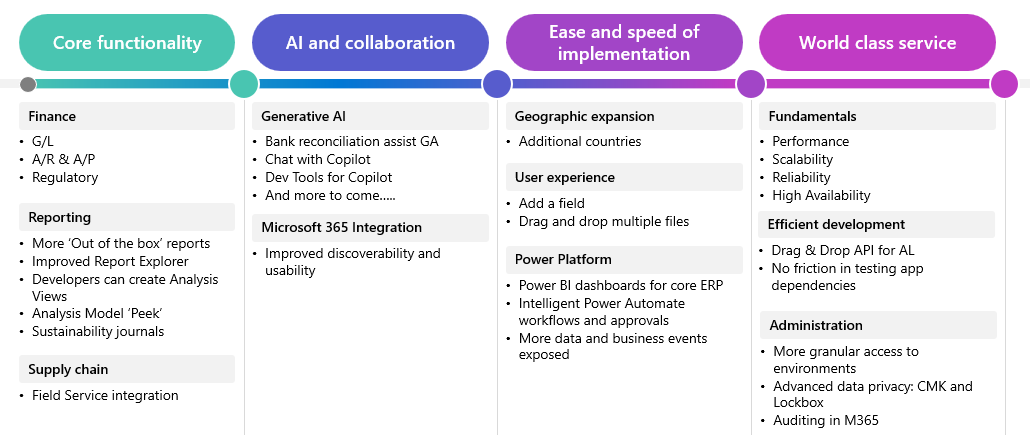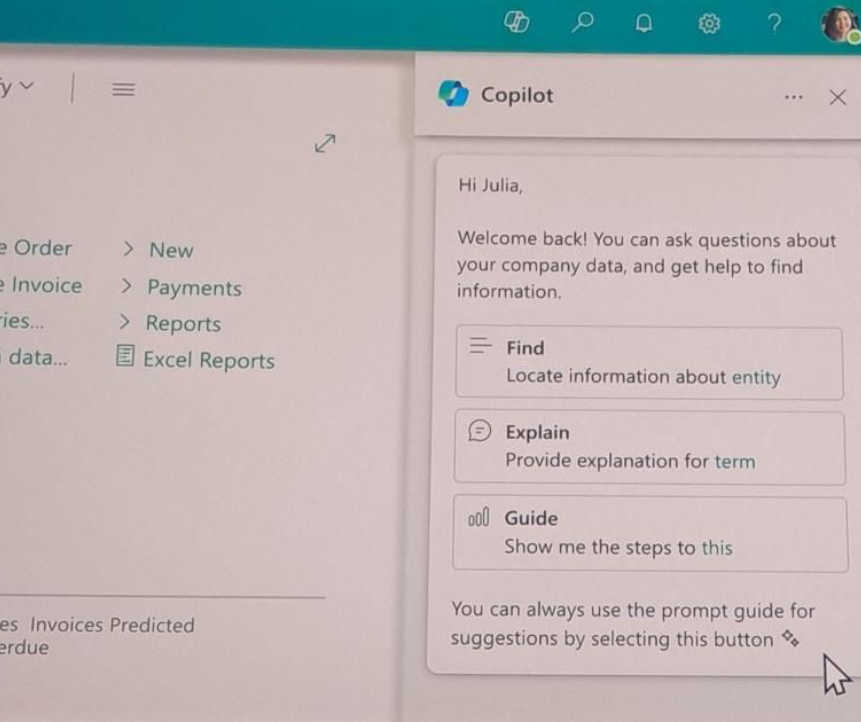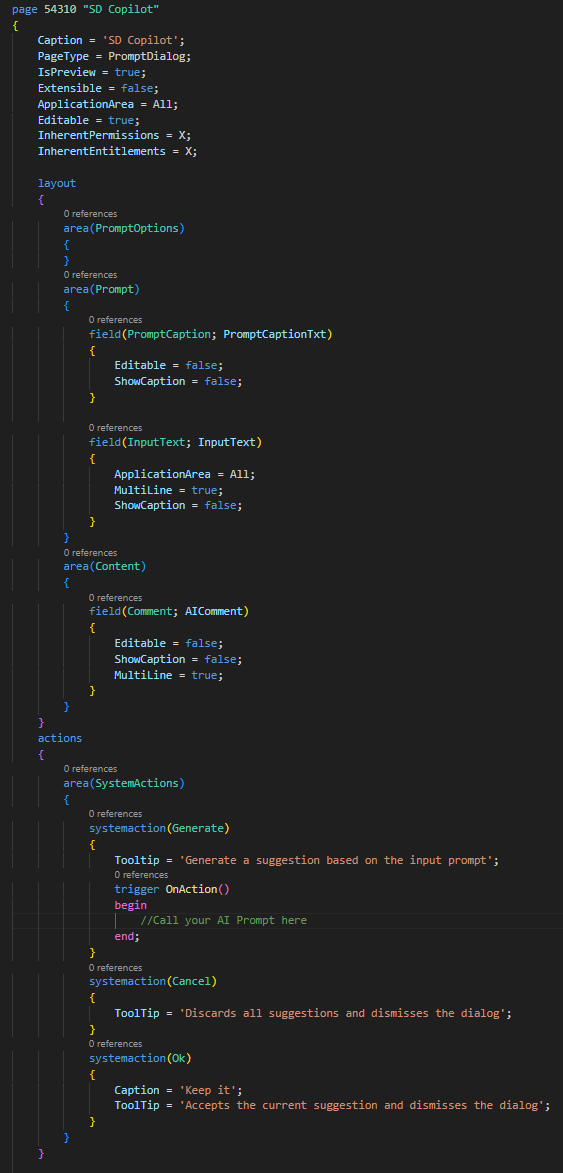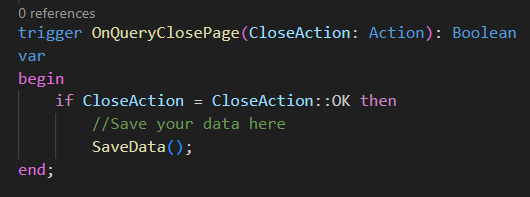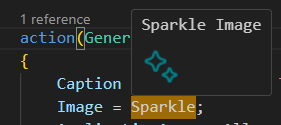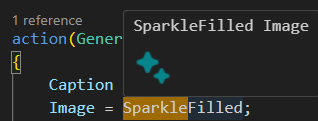Recap from Directions EMEA 2023
Directions EMEA 2023 in Lyon is finished in 2 weeks. Directions EMEA is always an excellent opportunity to network, gain knowledge, see new things, and understand the future and how our beloved ERP is moving.
Lots of new information was shared at the conference from the various speakers, and making a summarization takes work. In this post, I want to focus on some important aspects, and I want to start doing that by sharing the Dynamics 365 Business Central 2024 Wave 1 roadmap:
It’s the first time we see a column header in the roadmap chart talking about AI.
AI is transforming the role of technology. From tools, it moves to creative assistants; from data input, it moves to data output; from following commands, it moves to provide recommendations, with humans in the loop; from using a specialized language, it moves to use a natural language to retrieve information or perform tasks.
In the last months, you’ve undoubtedly heard the word “Copilot” everywhere. Copilot democratizes AI across the Microsoft Cloud. We have:
- Dynamics 365 Copilot: AI-powered assistance in Dynamics 365 applications.
- Copilot in Power Platform: permits you to build apps using natural language and no-code technologies.
- Microsoft 365 Copilot: integrated AI into the M365 products.
- Microsoft Security Copilot: AI for security.
- Windows Copilot: the first centralized AI assistance on an OS platform.
- Github Copilot: helps write better code with the power of AI.
- Copilot for Azure: an AI companion that helps you design, operate, optimize, and troubleshoot your cloud infrastructure and services (announced these days at Ignite).
And what about Dynamics 365 Business Central?
The roadmap is clear: AI in the ERP is one of the top priorities. Microsoft started to introduce the possibility of using generative AI features in Dynamics 365 Business Central with version 22 (marketing text generations).
With version 23.1, Microsoft introduces a step more: a new bank reconciliation assistance based on generative AI using the standard Copilot user-interface.
But more than this is coming…
The big plans are for version 24, where you will see a more immersive AI experience inside Business Central:
The focus point of these AI features will be the following:
- Driving users to do tasks better: AI can help the user according to the context of the actions he’s trying to perform in the ERP.
- Explain the data to users.
- Find data-driven information inside the ERP (my personal top feature).
In the roadmap, another topic in the entire AI ecosystem inside Business Central significantly impacts Dev Tools for Copilots.
The Copilot Developer Toolkit inside Business Central is a combination of UI components and a set of AL objects that will help developers integrate AI functionalities inside the ERP by respecting UI design styles and integration guidelines.
The Copilot Developer Toolkit introduces a new page type called Prompt Dialog. This new UI component permits user interaction with Copilot (AI), respecting the UI design you will see across all Dynamics 365 products. To use this new object, runtime 12.1 is required:
Here is an example of how to create this UI in AL code using the new object:
Adding a systemaction object with the Generate type allows your Copilot control to accept a prompt and generate content. When using this control, it’s absolutely important to respect the UI guidelines, so:
- The control needs to have OK and Cancel systemaction objects that permit the user to accept or decline the result of the AI call.
- You can also (optional) add a systemaction (Regenerate) control if you want to regenerate a new AI call.
You can then save the result of the AI call into the Business Central database by using the OnQueryClosePage trigger (don’t do that in the OnAction trigger of the OK system action, or you will have an error):
To use generative AI with the Copilot UI in Dynamics 365 Business Central, you also need to:
- Create an instance of an Azure OpenAI model.
- Register your Copilot capabilities using the Azure OpenAI codeunit and calling the SetCopilotCapability
When calling Copilot actions from Business Central, remember always to use the new Sparkle and SparkeFilled icons to respect the Copilot UI guidelines:
The Copilot UI guidelines say that by default, you should use the Sparkle icon for all Copilot actions. If multiple Copilot actions exist in an area, and one is considered more “important” or needs to be emphasized, then use the SparkleFilled icon. Typically, you should have zero or one “filled” action, and the rest should use the standard Sparkle icon.
It’s not the goal of this post to explain every step of this integration, but just remember also that it’s quite different to “play” with an Azure OpenAI instance for demo purposes and instead use Azure OpenAI in production inside a Business Central environment where lots of users could use Copilot features a lot. You will have problems with token limits, rate limits, and performances. More advanced techniques should be used for handling these scenarios, I will talk about that shortly.
Copilot features will be available for Business Central SaaS only. Dynamics 365 Copilot is currently available with a Business Central license at no additional cost.
Remember that with Copilot in Business Central, you are the pilot, and data is your data. Your data is not used to train the foundation AI models, and your data is protected and secured.
Another important topic introduced at Directions EMEA was the Business Foundation layer, a set of horizontal ERP related functionalities used by all or none of the application domains. It’s built as modules (like in the system application) between the System Application and the Base Application.
This will change (the promise is in a non-breaking way) how the future Business Central structure will be handled.
This layer and the system application are now fully open source on the new BCApps repository, available at the following link.
Microsoft will also work on future code changes in this repo, so all platforms are now open to contributions and code discussions. The main branch points to the next major release.
The repo at the moment contains only the System Application, but soon you will have the Base Application and the new Business Foundation layer.
Integration with Power Platform will always be an important aspect of the future Business Central plans. In V24 expect to have:
- Support for Power Pages via Dataverse Virtual tables.
- Support for building flows with Copilot within Business Central
- More resilient data change events
- Advanced approval flows
- Improvements on out-of-the-box APIs exposed to the Power Platform
These are all exciting features planned for the near future. But what about the present?
Whoever follows me knows that I’m always interested in cloud services’ performance and scalability topics. I think that one of the great messages that this year’s Directions keynote has shared with partners is the reliability and scalability of the Business Central SaaS platform.
This is one of the common questions that partners and customers raise: is my business able to work well in the cloud platform? Am I secure in the cloud?
The answer is YES, and you don’t need to be worried about that. The Directions keynote shows some numbers like 99.98% uptime of the platform, 53.5K posted sales invoices in one day, 2.6M of posted sales lines in a day, and so on, more than 40 microservices that handle the scale of the platform, data security guaranteed and so on.
Conclusion
Some days ago, I decided to go more in-depth into these numbers, and I’ve written this post, sharing with you some internal numbers and why you need to trust the cloud. You can read the post here.
The future is brilliant for Business Central, and the always-growing number of customers adopting this platform (+75% monthly active users YoY in 155 countries) is a clear sign of that. The ERP is becoming more resilient, open, and now also AI-ready.
If you want a future-proof ERP that can satisfy your business needs, probably you should put an eye on this green logo:
